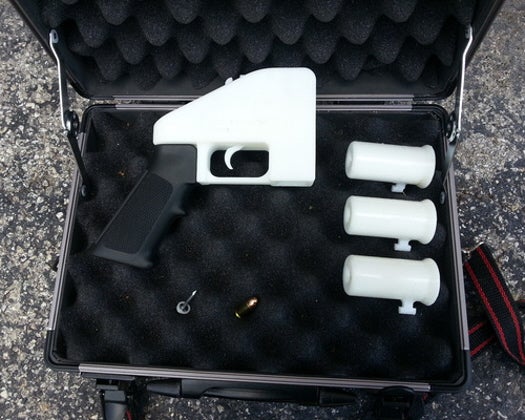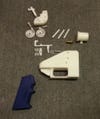How The World’s First 3-D Printed Gun Works
Defense Distributed creates a fully functional gun, with 3-D printed plastic parts.

It started with a crowdfunding project last August. Now, nine months later, the world’s first 3-D printed gun is here. Announced via Forbes exclusive on Friday, the design, called the Liberator, is now available for download.
Here are what the parts look like:

The Liberator 3D Printed Gun, disassembled
Before making a complete 3-D printed gun, Defense Distributed tested a printed part of an assault rifle. In December, the test version fired 6 shots (out of a magazine of 10) before breaking. Defense Distributed have been refining their technology since, adapting to the needs of the material–by curving the plastic wherever possible to strengthen it against stress that broke square parts and thickening the plastic so that it better absorbs force. A later design, demonstrated in February, fired 600 rounds just fine. With a firearms manufacturing license in March, Defense Distributed was legally in the clear to make a 3-D printed gun they could sell.
In this latest demo, there are 16 3-D printed plastic components. A sharp eye will notice one metal component (besides the bullet): a cheap nail. This is the firing pin, which accelerates into the back of the round, setting of the explosion that propels the bullet forward. Defense Distributed tried to make a hardened plastic firing pin, but they were unable to do so with the commercial printer that they used to make the rest of the Liberator, and so rather than use an industrial printer they went with a cheap, everyday component.
The bullet is a .380 caliber, a size in use for ever a century and common in handguns. Why the .380? “It was the first one that worked,” Defense Distributed’s Cody Wilson told Popular Science. There are plans for 9mm and .22 caliber barrels as well.
The two coiled spirals and the weird, accordion-looking piece are all actually springs, made entirely of printed plastic. The spirals cock the accordion into position. The accordion is the trigger spring, that when released pushes the firing pin forward with enough force to set off the round.
Not visible in the picture is a nonfunctional 6-ounce piece of metal that goes in the handle and makes the gun visible to metal detectors, designed to meet the standards of the Undetectable Firearms Act. Wilson said he was interested in the printable quality of the gun, not the undetectable aspects of it, and while carefully noting hisType 7 License for firearms manufacture doesn’t require it, he made it detectable as a gesture of good will. Because this is optional, other people who choose to download the plans and print their own Liberators may not follow suit. (Fiction, at least, has already seen the dangerous potential of undetected guns).
Is this the future of 3D printing? Wilson told the BBC:
“There are states all over the world outside of the United States say we’re a gun control state, you can’t own a firearm. That’s not true anymore. I’m seeing a world where technology says you’ll be pretty much be able to have whatever you want.”
You can watch the Liberator in action here:

